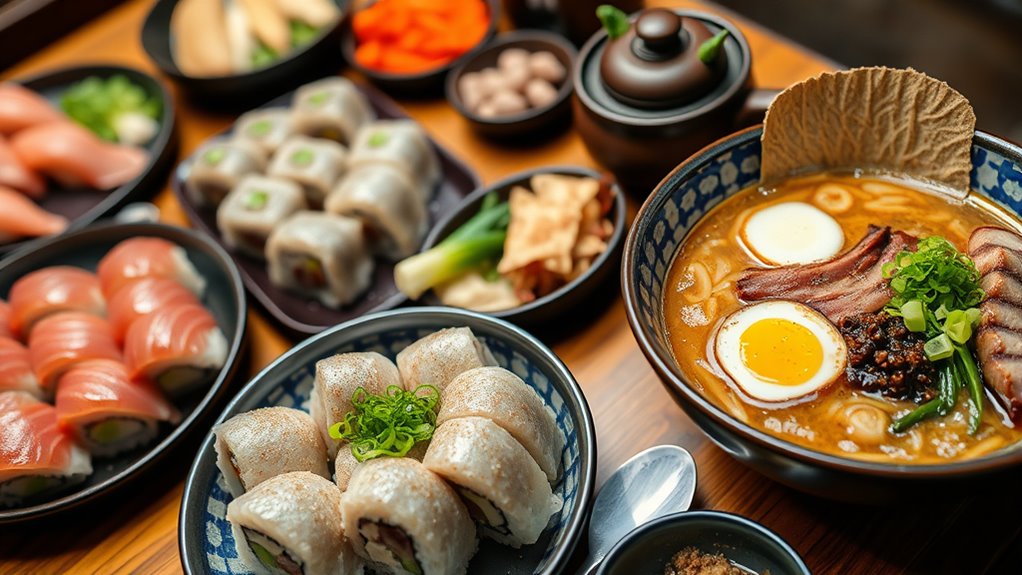Japanese cuisine beautifully combines tradition, craftsmanship, and fresh ingredients to create dishes like sushi and ramen. Sushi highlights artful presentation and delicate flavors, while ramen showcases regional diversity through rich broths and toppings. Both exemplify Japan’s dedication to harmony, balance, and culinary mastery. Each dish reflects a deep cultural history and regional pride. If you explore further, you’ll discover the layers of meaning behind these iconic foods and their role in Japanese culture.
Key Takeaways
- Japanese cuisine emphasizes harmony, seasonality, and presentation, showcasing centuries-old culinary traditions.
- Sushi highlights craftsmanship, artistic presentation, and the balance of flavors using fresh ingredients.
- Ramen reflects regional diversity with various broths, toppings, and meticulous preparation, symbolizing culinary pride.
- Both dishes exemplify Japan’s dedication to craftsmanship, visual appeal, and cultural respect in food.
- Exploring Japanese cuisine offers insight into its rich history, cultural values, and innovative culinary techniques.

Have you ever wondered what makes Japanese cuisine so unique and beloved worldwide? It’s a fascinating blend of tradition, craftsmanship, and fresh ingredients that come together to create dishes unlike any other. When you think of Japan’s culinary offerings, sushi probably springs to mind first. But it’s more than just raw fish wrapped in rice; it’s an art form that emphasizes balance, presentation, and harmony of flavors.
You’ll notice how each piece is carefully crafted, with chefs paying close attention to the quality of the fish and the precise way it’s sliced. Sushi isn’t just about taste; it’s about the experience of eating something beautiful and thoughtfully prepared. As you sample different types—nigiri, sashimi, or maki—you’ll discover how the subtle interplay of flavors and textures keeps your palate engaged. Sushi’s origins trace back centuries, but it’s evolved into a global phenomenon, showcasing Japan’s dedication to culinary excellence.
Moving from sushi, ramen offers another glimpse into Japan’s culinary diversity. This hearty noodle soup is a comfort food that varies widely across regions, each boasting its own twist. You might find rich, pork-based broths in the south or lighter, soy-infused options in the north.
As you dig into a steaming bowl, you’ll notice how the noodles absorb the savory broth, blending flavors that are both satisfying and complex. Ramen shops often take pride in their broth recipes, some simmering for hours to develop deep, umami-rich flavors. The toppings—soft-boiled eggs, slices of chashu pork, bamboo shoots, green onions—add layers of texture and taste, transforming a simple bowl of noodles into a culinary masterpiece.
Ramen isn’t just fast food; it’s a carefully curated dish that reflects regional pride and culinary innovation. Watching a skilled chef prepare it can be mesmerizing, as each step is executed with precision.
Japanese cuisine isn’t just about individual dishes; it’s about an entire philosophy that values seasonality, presentation, and harmony. From the meticulous way ingredients are selected to the artful plating, every element demonstrates a respect for nature and tradition. Additionally, cookie consent management plays a crucial role in how websites like Fokos handle user data and privacy preferences, ensuring transparency and control.
Whether you’re savoring delicate sushi or slurping flavorful ramen, you’re participating in a culinary journey that celebrates craftsmanship and cultural history. Exploring Japan’s food scene offers endless surprises, inviting you to appreciate the subtlety and depth that make Japanese cuisine truly special.
Frequently Asked Questions
What Are the Health Benefits of Traditional Japanese Ingredients?
You’re asking about the health benefits of traditional Japanese ingredients. These foods are rich in nutrients that support your health, like omega-3 fatty acids from fish, which boost brain and heart health.
You also get antioxidants from ingredients like seaweed and green tea that protect your cells. Additionally, Japanese ingredients often have low calories and high fiber, helping with weight management and digestion.
Including them can boost your overall well-being naturally.
How Is Seasonal Variation Reflected in Japanese Dishes?
You’ll notice that around 80% of Japanese dishes highlight seasonal ingredients, reflecting the culture’s deep respect for nature’s cycles. Seasonal variation influences everything from the freshness of fish in sushi to the vegetables in hot pots.
You experience this by savoring spring’s bamboo shoots or autumn’s mushrooms, which not only enhance flavor but also connect you to Japan’s changing landscape, making each meal a celebration of the current season.
What Is the Etiquette for Eating Sushi Properly?
When eating sushi properly, you should use your hands or chopsticks, but hands are traditional for nigiri.
Dip sushi lightly into soy sauce, fish side down, to avoid overpowering the delicate flavor.
Eat the sushi in one bite, savoring the taste.
Avoid mixing wasabi directly into soy sauce.
Remember to express gratitude with a simple “itadakimasu” before eating and “gochisousama deshita” afterward to show appreciation.
Are There Regional Differences in Ramen Styles Across Japan?
You might think ramen styles are uniform across Japan, but regional differences are quite real. In Hokkaido, you’ll find hearty miso ramen perfect for cold weather, while in Kyushu, tonkotsu ramen with rich pork broth rules.
Each region adapts ingredients and flavors to local tastes, so your experience varies. Exploring these styles reveals Japan’s diverse culinary culture, making ramen more than just a quick meal—it’s a regional expression.
How Has Japanese Cuisine Influenced Global Food Trends?
Japanese cuisine has markedly shaped global food trends by introducing you to diverse flavors and innovative presentation styles. You might notice how sushi, ramen, and tempura have become popular worldwide, inspiring chefs to incorporate Japanese techniques and ingredients into their menus.
This influence encourages you to explore new culinary experiences, blending traditional Japanese elements with local tastes, ultimately enriching your dining options and fostering a greater appreciation for Japanese culinary artistry.
Conclusion
As you immerse yourself in Japanese cuisine, you’ll find it’s like a vibrant tapestry of flavors and traditions. From the delicate artistry of sushi to the comforting warmth of ramen, each dish offers a unique story. Embrace the journey, and let your taste buds explore this rich culinary world. Just as a koi fish gracefully moves through water, your appreciation for Japanese food will flow effortlessly, revealing its beauty and depth with every bite.









